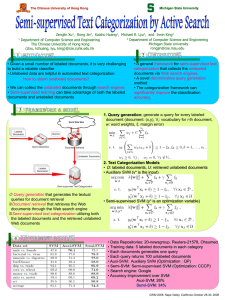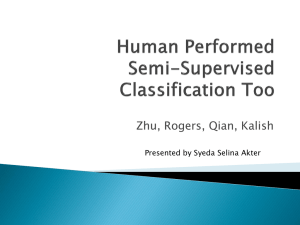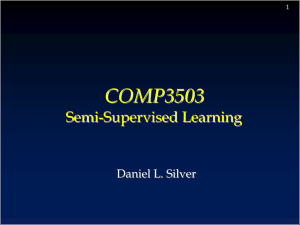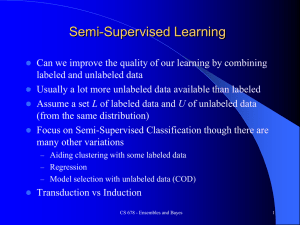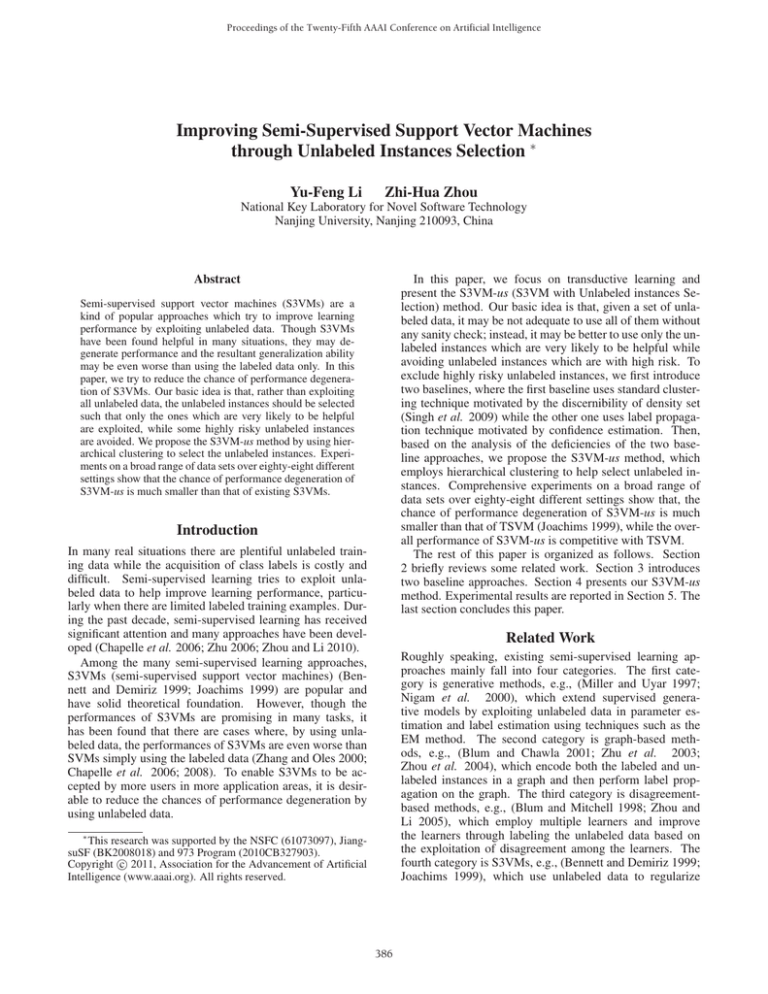
Proceedings of the Twenty-Fifth AAAI Conference on Artificial Intelligence
Improving Semi-Supervised Support Vector Machines
through Unlabeled Instances Selection ∗
Yu-Feng Li
Zhi-Hua Zhou
National Key Laboratory for Novel Software Technology
Nanjing University, Nanjing 210093, China
In this paper, we focus on transductive learning and
present the S3VM-us (S3VM with Unlabeled instances Selection) method. Our basic idea is that, given a set of unlabeled data, it may be not adequate to use all of them without
any sanity check; instead, it may be better to use only the unlabeled instances which are very likely to be helpful while
avoiding unlabeled instances which are with high risk. To
exclude highly risky unlabeled instances, we first introduce
two baselines, where the first baseline uses standard clustering technique motivated by the discernibility of density set
(Singh et al. 2009) while the other one uses label propagation technique motivated by confidence estimation. Then,
based on the analysis of the deficiencies of the two baseline approaches, we propose the S3VM-us method, which
employs hierarchical clustering to help select unlabeled instances. Comprehensive experiments on a broad range of
data sets over eighty-eight different settings show that, the
chance of performance degeneration of S3VM-us is much
smaller than that of TSVM (Joachims 1999), while the overall performance of S3VM-us is competitive with TSVM.
The rest of this paper is organized as follows. Section
2 briefly reviews some related work. Section 3 introduces
two baseline approaches. Section 4 presents our S3VM-us
method. Experimental results are reported in Section 5. The
last section concludes this paper.
Abstract
Semi-supervised support vector machines (S3VMs) are a
kind of popular approaches which try to improve learning
performance by exploiting unlabeled data. Though S3VMs
have been found helpful in many situations, they may degenerate performance and the resultant generalization ability
may be even worse than using the labeled data only. In this
paper, we try to reduce the chance of performance degeneration of S3VMs. Our basic idea is that, rather than exploiting
all unlabeled data, the unlabeled instances should be selected
such that only the ones which are very likely to be helpful
are exploited, while some highly risky unlabeled instances
are avoided. We propose the S3VM-us method by using hierarchical clustering to select the unlabeled instances. Experiments on a broad range of data sets over eighty-eight different
settings show that the chance of performance degeneration of
S3VM-us is much smaller than that of existing S3VMs.
Introduction
In many real situations there are plentiful unlabeled training data while the acquisition of class labels is costly and
difficult. Semi-supervised learning tries to exploit unlabeled data to help improve learning performance, particularly when there are limited labeled training examples. During the past decade, semi-supervised learning has received
significant attention and many approaches have been developed (Chapelle et al. 2006; Zhu 2006; Zhou and Li 2010).
Among the many semi-supervised learning approaches,
S3VMs (semi-supervised support vector machines) (Bennett and Demiriz 1999; Joachims 1999) are popular and
have solid theoretical foundation. However, though the
performances of S3VMs are promising in many tasks, it
has been found that there are cases where, by using unlabeled data, the performances of S3VMs are even worse than
SVMs simply using the labeled data (Zhang and Oles 2000;
Chapelle et al. 2006; 2008). To enable S3VMs to be accepted by more users in more application areas, it is desirable to reduce the chances of performance degeneration by
using unlabeled data.
Related Work
Roughly speaking, existing semi-supervised learning approaches mainly fall into four categories. The first category is generative methods, e.g., (Miller and Uyar 1997;
Nigam et al. 2000), which extend supervised generative models by exploiting unlabeled data in parameter estimation and label estimation using techniques such as the
EM method. The second category is graph-based methods, e.g., (Blum and Chawla 2001; Zhu et al. 2003;
Zhou et al. 2004), which encode both the labeled and unlabeled instances in a graph and then perform label propagation on the graph. The third category is disagreementbased methods, e.g., (Blum and Mitchell 1998; Zhou and
Li 2005), which employ multiple learners and improve
the learners through labeling the unlabeled data based on
the exploitation of disagreement among the learners. The
fourth category is S3VMs, e.g., (Bennett and Demiriz 1999;
Joachims 1999), which use unlabeled data to regularize
∗
This research was supported by the NSFC (61073097), JiangsuSF (BK2008018) and 973 Program (2010CB327903).
c 2011, Association for the Advancement of Artificial
Copyright Intelligence (www.aaai.org). All rights reserved.
386
Algorithm 1 S3VM-c
the decision boundary to go through low density regions
(Chapelle and Zien 2005).
Though semi-supervised learning approaches have shown
promising performances in many situations, it has been indicated by many authors that using unlabeled data may hurt
the performance (Nigam et al. 2000; Zhang and Oles 2000;
Cozman et al. 2003; Zhou and Li 2005; Chawla and Karakoulas 2005; Lafferty and Wasserman 2008; Ben-David et al.
2008; Singh et al. 2009). In some application areas, especially the ones which require high reliability, users might be
reluctant to use semi-supervised learning approaches due to
the worry of obtaining a performance worse than simply neglecting unlabeled data. As typical semi-supervised learning
approaches, S3VMs also suffer from this deficiency.
The usefulness of unlabeled data has been discussed theoretically (Lafferty and Wasserman 2008; Ben-David et al.
2008; Singh et al. 2009) and validated empirically (Chawla
and Karakoulas 2005). Many literatures indicated that unlabeled data should be used carefully. For generative methods,
Cozman et al. (2003) showed that unlabeled data can increase error even in situations where additional labeled data
would decrease error. One main conjecture on the performance degeneration is attributed to the difficulties of making
a right model assumption which prevents the performance
from degenerated by fitting with unlabeled data. For graphbased methods, more and more researchers recognize that
graph construction is more crucial than how the labels are
propagated, and some attempts have been devoted to using domain knowledge or constructing robust graphs (Balcan et al. 2005; Jebara et al. 2009). As for disagreementbased method, the generalization ability has been studied
with plentiful theoretical results based on different assumptions (Blum and Mitchell 1998; Dasgupta et al. 2002;
Wang and Zhou 2007; 2010). As for S3VMs, the correctness of the S3VM objective has been studied on small data
sets (Chapelle et al. 2008).
It is noteworthy that though there are many work devoted
to cope with the high complexity of S3VMs (Joachims 1999;
Collobert et al. 2006; Chapelle et al. 2008; Li et al. 2009),
there was no proposal on how to reduce the chance of performance degeneration by using unlabeled data. There was
a relevant work which uses data editing techniques in semisupervised learning (Li and Zhou 2005); however, it tries to
remove or fix suspicious unlabeled data during training process, while our proposal tries to select unlabeled instances
for S3VM and SVM predictions after the S3VM and SVM
have already been trained.
Input: ySV M , yS3V M , D and parameter k
1: Perform partitional clustering (e.g., kmeans) on D. Denote
C1 , . . . , Ck as the data indices of each cluster respectively.
2: For each cluster i = 1, . . . , k, calculate the label bias lb and
confidence cf of SVM and S3VM according to:
⎛
⎞
i
yS(3)V M (xj )⎠
lbS(3)V M = sign ⎝
j∈Ci
i
cfS(3)V
M
=
.
y
(x
)
j
S(3)V
M
j∈Ci
i
i
3: If lbiSV M = lbiS3V M & cfS3V
M > cfSV M , use the prediction of S3VM; otherwise use the prediction of SVM.
all the unlabeled data are high risky and therefore only labeled data are used.
Specifically, we consider the following problem: Once we
have obtained the predictions of inductive SVM and S3VM,
how to remove risky predictions of S3VM such that the resultant performance could be often better and rarely worse
than that of inductive SVM?
There are two simple ideas that are easy to be worked
out to address the above problem, leading to two baseline
approaches, namely S3VM-c and S3VM-p.
In the sequel, suppose we are given a training data set
D = L U where L = {(x1 , y1 ), . . . , (xl , yl )} denotes
the set of labeled data and U = {xl+1 , . . . , xl+u } denotes
the set of unlabeled data. Here x ∈ X is an instance and
y ∈ {+1, −1} is the label. We further let ySV M (x) and
yS3V M (x) denote the predicted labels on x by inductive
SVM and S3VM, respectively.
S3VM-c
The first baseline approach is motivated by the analysis in
(Singh et al. 2009) which suggests that unlabeled data help
when the component density sets are discernable. Here,
one can simulate the component density sets by clusters
and discernibility by a condition of disagreements between
S3VM and inductive SVM. We consider the disagreement
using two factors, i.e., bias and confidence. When S3VM
obtains the same bias as inductive SVM and enhances the
confidence of inductive SVM, one should use the results of
S3VM; otherwise it may be risky if we totally trust the prediction of S3VM.
Algorithm 1 gives the S3VM-c method and Figure 1(d) illustrates the intuition of S3VM-c. As can be seen, S3VM-c
inherits the correct predictions of S3VM on groups {1, 4}
while avoids the wrong predictions of S3VM on groups
{7, 8, 9, 10}.
Two Baseline Approaches
As mentioned, our intuition is to use only the unlabeled data
which are very likely to help improve the performance and
keep the unlabeled data which are with high risk to be unexploited. In this way, the chance of performance degeneration may be significantly reduced. Current S3VMs can
be regarded as an extreme case which believes that all unlabeled data are with low risk and therefore all of them should
be used; while inductive SVMs which use labeled data only
can be regarded as another extreme case which believes that
S3VM-p
The second baseline approach is motivated by confidence
estimation in graph-based methods, e.g., (Zhu et al. 2003),
where the confidence can be naturally regarded as a risk
measurement of unlabeled data.
387
(a)
(b)
(c)
(d)
(e)
(f)
Figure 1: Illustration with artificial three-moon data. (a) Labeled data (empty and filled circles) and unlabeled data (gray points). The
blocked numbers highlight groups of four unlabeled instances. Classification results of (b) Inductive SVM (using labeled data only); (c)
S3VM; (d) S3VM-c, where each circle presents a cluster; (e) S3VM-p; (f) Our proposed S3VM-us.
Algorithm 2 S3VM-p
Formally, to estimate the confidence of unlabeled data, let
Fl = [(yl +1)/2, (1−yl )/2] ∈ {0, 1}l×2 be the label matrix
for labeled data where yl = [y1 , . . . , yl ] ∈ {±1}l×1 is the
label vector. Let W = [wij ] ∈ R(l+u)×(l+u) be the weight
matrix of training data and Λ is the laplacian of W, i.e.,
Λ = D − W where
D = diag(di ) is a diagonal matrix with
entries di =
j wij . Then, the predictions of unlabeled
data can be obtained by (Zhu et al. 2003)
l
Fu = Λ−1
u,u Wu,l F ,
Input: ySV M , yS3V M , D, W and parameter η
1: Perform label propagation (e.g., (Zhu et al. 2003)) with W,
obtain the predicted label ylp (xi ) and confidence hi for each
unlabeled instance xi , i = l + 1, . . . , l + u.
2: Update h according to
hi = yS3V M (xi )ylp (xi )hi , i = l + 1, . . . , l + u.
Let c denote the number of nonnegative entries in h.
3: Sort h, pick up the top-min{ηu, c} values and use the predictions of S3VM for the corresponding unlabeled instances,
otherwise use the predictions of SVM.
(1)
where Λu,u is the sub-matrix of Λ with respect to the
block of unlabeled data, while Wu,l is the sub-matrix of
W with respect to the block between labeled and unlabeled data. Then, assign each point xi with the label
yLabP o (xi ) = sgn(Fui−l,1 − Fui−l,2 ) and the confidence
hi = |Fui−l,1 − Fui−l,2 |. After confidence estimation, similar
to S3VM-c, we consider the risk of unlabeled data by two
factors, i.e., bias and confidence. If S3VM obtains the same
bias of label propagation and the confidence is high enough,
we use the S3VM prediction, and otherwise we take SVM
prediction.
Algorithm 2 gives the S3VM-p method and Figure 1(e)
illustrates the intuition of S3VM-p. As can be seen, the correct predictions of S3VM on groups {2, 3} are inherited by
S3VM-p, while the wrong predictions of S3VM on groups
{7, 8, 9, 10} are avoided.
(Wang et al. 2008), the confidence estimated by label propagation approach might be incorrect if the label initialization
is highly imbalanced, leading to the unexploitation of some
useful unlabeled instances, e.g., groups {4, 5} in Figure 2(e).
Moreover, both S3VM-c and S3VM-p heavily rely on the
predictions of S3VM, which might become a serious issue
especially when S3VM obtains degenerated performance.
Figures 2(b) and 2(c) illustrate the behaviors of S3VM-c
and S3VM-p when S3VM degenerates performance. Both
S3VM-c and S3VM-p erroneously inherit the wrong predictions of S3VM of group 1.
S3VM-us
The deficiencies of S3VM-c and S3VM-p suggest to take
into account of cluster relation and make the method insensitive to label initialization. This motivates us to use hierarchical clustering (Jain and Dubes 1988), leading to our proposed method S3VM-us.
Hierarchical clustering works in a greedy and iterative
manner. It first initials each singe instance as a cluster and
then at each step, it merges two clusters with the shortest
distance among all pairs of clusters. In this step, the cluster
relation is considered and moreover, since hierarchical clustering works in an unsupervised setting, it does not suffer
Our Proposed Method
Deficiencies of S3VM-c and S3VM-p
S3VM-c and S3VM-p are capable of reducing the chances
of performance degeneration by using unlabeled data, however, they both suffer from some deficiencies. For S3VM-c,
it works in a local manner and the relation between clusters are never considered, leading to the unexploitation of
some helpful unlabeled instances, e.g., unlabeled instances
in groups {2, 3} in Figure 2(d). For S3VM-p, as stated in
388
(c)
(b)
(a)
(d)
Figure 2: Illustration with artificial two-moon data when S3VM degenerates performance. (a) Labeled data (empty and filled circles) and
unlabeled data (gray points). The blocked number highlight a group of four unlabeled instances. Classification results of (b) S3VM-c, where
each circle presents a cluster; (c) S3VM-p; (d) Our proposed S3VM-us.
Algorithm 3 S3VM-us
cies and standard deviations are recorded. It is worth noting
that in semi-supervised learning, labeled examples are often too few to afford a valid cross validation, and therefore
hold-out tests are usually used for the evaluation.
In addition to S3VM-c and S3VM-p, we compare with inductive SVM and TSVM3 (Joachims 1999). Both linear and
Gaussian kernels are used. For the benchmark data sets, we
follow the setup in (Chapelle et al. 2006). Specifically, for
the case of 10 labeled examples, the parameter C for SVM
m
is fixed to m/ i=1 xi 2 where m = l + u is the size of
data set and the Gaussian kernel width is set to δ, i.e., the
average distance between instances. For the case of 100 labeled examples, C is fixed to 100 and the Gaussian kernel
width is selected from {0.25δ, 0.5δ, δ, 2δ, 4δ} by cross validation. On UCI data sets, the parameter C is fixed to 1 and
the Gaussian kernel width is set to δ for 10 labeled examples. For 100 label examples, the parameter C is selected
from {0.1, 1, 10, 100} and the Gaussian kernel width is selected from {0.25δ, 0.5δ, δ, 2δ, 4δ} by cross validation. For
S3VM-c, the cluster number k is fixed to 50; for S3VM-p,
the weighted matrix is constructed via Gaussian distance and
the parameter η is fixed to 0.1; for S3VM-us, the parameter
is fixed to 0.1.
Input: ySV M , yS3V M , D and parameter 1: Let S be a set of the unlabeled data x such that ySV M (x) =
yS3V M (x).
2: Perform hierarchical clustering, e.g., single linkage method
(Jain and Dubes 1988).
3: For each unlabeled instance xi ∈ S, calculate pi and ni , that
is, the length of the paths from xi to its nearest positive and
negative labeled instances, respectively. Denote ti = (ni −pi ).
4: Let B be the set of unlabeled instances xi in S satisfying |ti | ≥
|l
+ u|.
5: If xi ∈B yS3V M (xi )ti ≥
xi ∈B ySV M (xi )ti , predict the
unlabeled instances in B by S3VM and otherwise by SVM.
6: Predict the unlabeled data x ∈ B by SVM.
from the label initialization problem.
Suppose pi and ni are the lengths of paths from the instance xi to its nearest positive and negative labeled instances, respectively, in hierarchical clustering. We simply
take the difference between pi and ni as an estimation of
the confidence on the unlabeled instance xi . Intuitively, the
larger the difference between pi and ni , the higher the confidence on labeling xi .
Algorithm 3 gives the S3VM-us method and Figures 1(f)
and 2 illustrate the intuition of S3VM-us. As can be seen,
the wrong predictions of S3VM on groups {7, 8, 9, 10} are
avoided by S3VM-us, the correct predictions of S3VM on
groups {2, 3, 4, 5} are inherited, and S3VM-us does not erroneously inherit the wrong predictions of S3VM on group
1 in Figure 2.
Results
The results are shown in Table 1. As can be seen, the performance of S3VM-us is competitive with TSVM. In terms
of average accuracy, TSVM performs slightly better (worse)
than S3VM-us on the case of 10 (100) labeled examples.
In terms of pairwise comparison, S3VM-us performs better
than TSVM on 13/12 and 14/16 cases with linear/Gaussian
kernel for 10 and 100 labeled examples, respectively. Note
that in a number of cases, TSVM has large performance improvement against inductive SVM, while the improvement
of S3VM-us is smaller. This is not a surprise since S3VMus tries to improve performance with the caution of avoiding
performance degeneration.
Though TSVM has large improvement in a number of
cases, it also has large performance degeneration in cases.
Indeed, as can be seen from Table 1, TSVM is significantly inferior to inductive SVM on 8/44, 19/44 cases for
10 and 100 labeled examples, respectively. Both S3VM-c
and S3VM-p are capable to reduce the times of significant
performance degeneration, while S3VM-us does not significantly degenerate performance in the experiments.
Experiments
Settings
We evaluate S3VM-us on a broad range of data sets including the semi-supervised learning benchmark data sets
in (Chapelle et al. 2006) and sixteen UCI data sets1 . The
benchmark data sets are g241c, g241d, Digit1, USPS, TEXT
and BCI. For each data, the archive2 provides two data sets
with one using 10 labeled examples and the other using 100
labeled examples. As for UCI data sets, we randomly select
10 and 100 examples to be used as labeled examples, respectively, and use the remaining data as unlabeled data. The experiments are repeated for 30 times and the average accura1
2
http://archive.ics.uci.edu/ml/
http://www.kyb.tuebingen.mpg.de/ssl-book/
3
389
http://svmlight. joachims.org/
Table 1: Accuracy (mean ± std.). ‘SVM’ denotes inductive SVM which uses labeled data only. For the semi-supervised methods (TSVM,
S3VM-c, S3VM-p and S3VM-us), if the performance is significantly better/worse than SVM, the corresponding entries are bolded/underlined
(paired t-tests at 95% significance level). The win/tie/loss counts with the fewest losses are bolded.
# labeled
10
# labeled
100
Data
SVM
( linear / gaussian )
BCI
50.7±1.5 / 52.7±2.7
53.2±4.8 / 53.0±4.5
g241c
g241d
54.4±5.4 / 54.5±5.2
55.4±10.9 / 75.0±7.9
digit1
80.0±0.1 / 80.7±1.8
USPS
54.7±6.3 / 54.6±6.3
Text
90.0±6.0 / 84.8±11.8
house
58.8±10.5 / 63.9±11.6
heart
heart-statlog
74.6±4.8 / 69.9±10.1
70.4±8.7 / 65.8±9.8
ionosphere
73.2±8.9 / 58.3±9.5
vehicle
85.5±7.0 / 79.7±10.7
house-votes
65.6±7.5 / 73.8±10.3
wdbc
58.2±4.2 / 53.5±6.2
clean1
isolet
93.8±4.3 / 82.0±15.7
93.9±4.8 / 92.3±10.1
breastw
australian
70.4±9.2 / 60.3±8.4
63.3±6.9 / 66.3±3.5
diabetes
german
65.2±4.9 / 65.1±12.0
96.1±3.2 / 92.8±9.6
optdigits
56.5±8.8 / 58.5±10.2
ethn
95.8±4.1 / 87.5±10.9
sat
Average Accuacy
70.9 / 69.3
SVM vs. Semi-Supervised: W/T/L
TSVM
( linear / gaussian )
49.3±2.8 / 51.4±2.7
78.9±4.7 / 78.5±5.0
53.6±7.8 / 53.2±6.5
79.4±1.1 / 81.5±3.1
69.4±1.2 / 73.0±2.6
71.4±11.7 / 71.2±11.4
84.6±8.0 / 84.7±6.9
72.4±12.6 / 72.6±10.4
74.9±6.6 / 73.9±5.9
72.0±10.5 / 76.1±8.2
72.1±9.4 / 63.2±7.8
83.8±6.1 / 84.0±5.3
90.0±6.1 / 88.9±3.7
57.0±5.1 / 53.3±4.8
84.2±10.9 / 86.7±9.5
89.2±8.6 / 88.9±8.8
69.6±11.9 / 68.6±11.4
63.4±7.6 / 65.8±4.6
63.7±5.6 / 63.5±5.1
89.8±9.2 / 91.4±7.6
64.2±13.5 / 68.1±14.5
85.5±11.4 / 86.5±10.8
73.5 / 73.8
18/18/8
S3VM-c
( linear / gaussian )
50.2±2.0 / 52.2±2.6
55.2±8.3 / 55.3±8.8
53.8±5.4 / 53.6±5.0
56.1±12.2 / 77.3±8.2
80.0±0.1 / 80.4±2.5
56.8±8.8 / 56.5±8.7
89.8±6.2 / 84.8±11.9
59.0±10.8 / 64.4±11.6
74.5±5.2 / 70.1±10.2
70.9±9.0 / 66.1±9.9
73.5±9.4 / 58.4±9.6
85.7±7.0 / 80.1±10.6
65.7±7.8 / 74.9±10.9
57.8±4.4 / 53.3±6.2
94.5±5.1 / 83.2±16.0
94.2±4.9 / 92.4±10.0
70.1±9.8 / 60.4±8.3
63.2±6.8 / 65.9±3.0
65.6±4.7 / 65.1±11.8
96.6±3.1 / 93.6±9.9
56.5±8.6 / 59.4±11.6
96.3±4.1 / 87.7±11.2
71.2 / 69.8
14/29/1
S3VM-p
( linear / gaussian )
50.6±1.6 / 52.6±2.7
53.9±5.8 / 53.6±5.3
54.1±5.3 / 54.0±5.2
56.2±12.2 / 75.0±8.1
80.0±0.1 / 80.5±2.1
55.3±6.6 / 55.2±6.8
89.5±6.0 / 84.5±11.8
58.6±10.6 / 63.8±11.7
74.5±4.9 / 70.0±10.2
70.4±8.7 / 66.0±9.7
72.6±9.1 / 58.0±9.5
85.3±6.9 / 79.7±10.7
66.1±8.0 / 73.9±10.5
58.5±4.2 / 53.3±6.3
93.0±4.7 / 81.7±15.7
93.9±4.9 / 92.2±10.0
70.5±9.4 / 60.5±8.8
63.4±6.6 / 66.2±3.4
65.6±4.8 / 65.1±11.9
95.6±3.0 / 92.4±9.8
56.8±9.1 / 58.6±10.7
94.8±4.2 / 86.9±10.8
70.9 / 69.3
7/25/12
S3VM-us
( linear / gaussian )
50.9±1.6 / 52.6±2.7
53.5±4.8 / 53.2±4.5
54.4±5.3 / 54.4±5.2
58.1±9.6 / 75.1±7.8
80.0±0.1 / 80.7±1.8
58.0±9.0 / 57.8±8.9
90.1±6.1 / 85.4±11.4
61.9±9.7 / 65.1±11.0
74.2±5.4 / 71.7±6.9
70.7±8.3 / 67.4±6.7
74.5±9.3 / 64.2±9.1
86.0±5.7 / 84.3±6.1
65.8±7.5 / 73.9±10.3
58.2±4.2 / 55.0±8.1
93.7±4.3 / 84.1±12.6
93.6±5.4 / 92.4±9.9
70.3±9.2 / 60.8±7.9
63.3±6.9 / 66.3±3.5
65.2±5.0 / 65.3±11.6
96.9±2.5 / 94.9±5.8
59.8±10.7 / 61.8±11.3
96.4±3.9 / 90.7±8.1
71.6 / 70.8
12/32/0
Data
TSVM
( linear / gaussian )
56.4±2.8 / 65.6±2.5
81.7±1.6 / 82.1±1.2
76.1±8.5 / 77.9±7.4
81.9±3.0 / 94.0±2.0
78.8±2.0 / 90.9±1.4
77.7±1.6 / 77.7±1.7
94.4±2.5 / 94.8±2.6
80.7±3.1 / 79.5±2.9
81.6±2.7 / 79.0±4.5
85.6±2.1 / 92.1±2.3
91.6±2.5 / 95.4±2.3
92.0±1.8 / 93.0±1.4
73.2±3.1 / 79.1±3.4
94.3±2.3 / 94.1±2.4
95.9±3.1 / 98.2±2.3
96.9±1.9 / 97.1±0.5
82.5±2.6 / 84.6±2.7
72.3±2.3 / 71.8±1.8
66.1±2.1 / 65.9±3.4
95.9±3.7 / 97.4±3.1
92.6±2.3 / 93.4±3.0
96.4±2.8 / 97.6±2.7
83.9 / 86.4
7/18/19
S3VM-c
( linear / gaussian )
58.3±2.6 / 65.6±3.0
79.3±1.7 / 79.6±1.8
77.4±3.5 / 78.5±3.3
50.3±1.2 / 95.0±1.5
80.0±0.2 / 92.5±1.0
75.3±3.4 / 75.2±3.6
95.5±1.8 / 95.4±1.8
81.1±3.0 / 79.8±2.5
81.2±2.2 / 80.7±3.0
88.7±1.3 / 93.4±1.5
93.3±1.6 / 95.9±1.3
92.6±1.2 / 92.9±1.2
73.7±2.9 / 79.9±2.9
95.8±0.7 / 94.9±0.9
99.2±0.4 / 99.2±0.5
96.6±0.4 / 96.9±0.4
83.8±1.7 / 85.0±1.6
74.9±1.7 / 74.2±2.2
67.1±2.2 / 71.6±1.5
99.5±0.4 / 99.5±0.3
93.9±1.6 / 95.0±1.2
99.7±0.2 / 99.8±0.1
83.5 / 87.3
21/16/7
S3VM-p
( linear / gaussian )
60.3±2.5 / 65.8±3.0
77.2±2.1 / 77.1±2.0
74.8±2.3 / 75.7±2.2
50.3±1.2 / 94.1±1.4
80.0±0.2 / 91.6±1.2
73.9±3.4 / 73.8±3.7
95.6±2.0 / 95.5±1.7
81.5±2.5 / 80.2±2.5
81.5±2.4 / 81.2±2.7
87.1±1.5 / 93.2±1.6
92.8±1.7 / 95.2±1.5
92.3±1.3 / 92.8±1.2
73.2±2.6 / 80.4±3.2
95.6±0.8 / 94.7±0.9
99.0±0.4 / 98.9±0.6
96.3±0.4 / 96.7±0.4
83.9±1.7 / 85.0±1.8
75.3±1.6 / 74.7±1.9
67.6±2.3 / 72.1±1.4
99.2±0.4 / 99.2±0.4
91.9±1.5 / 93.3±1.2
99.5±0.3 / 99.5±0.3
83.1 / 86.8
8/25/11
S3VM-us
( linear / gaussian )
61.0±2.7 / 65.8±3.1
76.3±2.0 / 76.6±2.1
74.2±1.9 / 75.4±1.8
67.9±1.3 / 94.1±1.4
80.1±0.4 / 91.8±1.1
74.1±3.1 / 74.2±3.3
95.6±2.0 / 95.6±1.6
81.5±2.6 / 80.1±2.4
81.5±2.4 / 81.3±2.7
87.1±1.5 / 93.2±1.6
93.0±1.7 / 95.5±1.4
92.3±1.3 / 92.8±1.2
73.1±2.7 / 80.7±3.0
95.6±0.8 / 94.8±0.9
99.2±0.4 / 99.1±0.5
96.4±0.4 / 96.7±0.4
83.8±1.7 / 85.0±1.7
75.2±1.8 / 74.7±1.9
67.1±2.4 / 72.1±1.5
99.5±0.3 / 99.4±0.3
91.7±1.5 / 93.4±1.2
99.7±0.2 / 99.7±0.1
83.9 / 86.9
8/36/0
SVM
( linear / gaussian )
BCI
61.1±2.6 / 65.9±3.1
76.3±2.0 / 76.6±2.1
g241c
74.2±1.9 / 75.4±1.8
g241d
50.3±1.2 / 94.0±1.4
digit1
USPS
80.0±0.2 / 91.7±1.1
73.8±3.3 / 73.7±3.6
Text
95.7±2.0 / 95.6±1.6
house
heart
81.5±2.5 / 80.1±2.4
81.5±2.4 / 81.4±2.7
heart-statlog
87.1±1.5 / 93.2±1.6
ionosphere
92.9±1.7 / 95.4±1.4
vehicle
house-votes
92.3±1.3 / 92.8±1.2
73.0±2.7 / 80.6±3.0
clean1
95.6±0.8 / 94.7±0.9
wdbc
99.2±0.4 / 99.0±0.6
isolet
96.4±0.4 / 96.7±0.4
breastw
83.8±1.6 / 84.9±1.7
australian
diabetes
75.2±1.7 / 74.7±1.9
german
67.1±2.4 / 72.0±1.5
99.4±0.3 / 99.4±0.3
optdigits
91.6±1.6 / 93.4±1.2
ethn
sat
99.7±0.2 / 99.7±0.1
Average Accuracy
83.0 / 86.8
SVM vs. Semi-Supervised: W/T/L
Parameter Influence
in Figure 3. It can be seen that the setting of has influence
on the improvement of S3VM-us against inductive SVM.
Whatever linear kernel or gaussian kernel is used, the larger
the value of , the closer the performance of S3VM-us to
S3VM-us has a parameter . To study the influence of ,
we run experiments by setting to different values (0.1, 0.2
and 0.3) with 10 labeled examples. The results are plotted
390
O. Chapelle and A. Zien. Semi-supervised learning by low density
separation. In AISTATS, pages 57–64, 2005.
O. Chapelle, B. Schölkopf, and A. Zien, editors. Semi-Supervised
Learning. MIT Press, Cambridge, MA, 2006.
O. Chapelle, V. Sindhwani, and S. S. Keerthi. Optimization techniques for semi-supervised support vector machines. J. Mach.
Learn. Res., 9:203–233, 2008.
N. V. Chawla and G. Karakoulas. Learning from labeled and unlabeled data: An empirical study across techniques and domains. J.
Artif. Intell. Res., 23:331–366, 2005.
R. Collobert, F. Sinz, J. Weston, and L. Bottou. Large scale transductive SVMs. J. Mach. Learn. Res., 7:1687–1712, 2006.
F. G. Cozman, I. Cohen, and M. C. Cirelo. Semi-supervised learning of mixture models. In ICML, pages 99–106, 2003.
S. Dasgupta, M. L. Littman, and D. McAllester. PAC generalization bounds for co-training. In NIPS 14, pages 375–382. 2002.
A.K. Jain and R.C. Dubes. Algorithms for Clustering Data. Prentice Hall, Englewood Cliffs, NJ., 1988.
T. Jebara, J. Wang, and S. F. Chang. Graph construction and bmatching for semi-supervised learning. In ICML, pages 441–448,
2009.
T. Joachims. Transductive inference for text classification using
support vector machines. In ICML, pages 200–209, 1999.
J. Lafferty and L. Wasserman. Statistical analysis of semisupervised regression. In NIPS 20, pages 801–808. 2008.
M. Li and Z. H. Zhou. SETRED: Self-training with editing. In
PAKDD, pages 611–621, 2005.
Y.-F. Li, J. T. Kwok, and Z.-H. Zhou. Semi-supervised learning
using label mean. In ICML, pages 633–640, 2009.
D. J. Miller and H. S. Uyar. A mixture of experts classifier with
learning based on both labelled and unlabelled data. In NIPS 9,
pages 571–577. 1997.
K. Nigam, A. K. McCallum, S. Thrun, and T. Mitchell. Text classification from labeled and unlabeled documents using EM. Mach.
Learn., 39(2):103–134, 2000.
A. Singh, R. Nowak, and X. Zhu. Unlabeled data: Now it helps,
now it doesn’t. In NIPS 21, pages 1513–1520. 2009.
W. Wang and Z.-H. Zhou. Analyzing co-training style algorithms.
In ECML, pages 454–465, 2007.
W. Wang and Z.-H. Zhou. A new analysis of co-training. In ICML,
pages 1135–1142, 2010.
J. Wang, T. Jebara, and S. F. Chang. Graph transduction via alternating minimization. In ICML, pages 1144–1151, 2008.
T. Zhang and F. Oles. The value of unlabeled data for classification
problems. In ICML, pages 1191–1198, 2000.
Z.-H. Zhou and M. Li. Tri-training: Exploiting unlabeled data using three classifiers. IEEE Trans. Knowl. Data Eng., 17(11):1529–
1541, 2005.
Z.-H. Zhou and M. Li. Semi-supervised learning by disagreement.
Knowl. Inf. Syst., 24(3):415–439, 2010.
D. Zhou, O. Bousquet, T. N. Lal, J. Weston, and B. Scholkopf.
Learning with local and global consistency. In NIPS 16, pages
595–602. 2004.
X. Zhu, Z. Ghahramani, and J. D. Lafferty. Semi-supervised learning using gaussian fields and harmonic functions. In ICML, pages
912–919, 2003.
X. Zhu. Semi-supervised learning literature survey. Technical Report 1530, Dept. Comp. Sci., Univ. Wisconsin-Madison, 2006.
Figure 3: Influence of the parameter on the improvement
of S3VM-us against inductive SVM.
SVM. It may be possible to increase the performance improvement by setting a smaller , however, this may increase
the risk of performance degeneration.
Conclusion
In this paper we propose the S3VM-us method. Rather
than simply predicting all unlabeled instances by semisupervised learner, S3VM-us uses hierarchical clustering
to help select unlabeled instances to be predicted by semisupervised learner and predict the remaining unlabeled instances by inductive learner. In this way, the risk of performance degeneration by using unlabeled data is reduced. The
effectiveness of S3VM-us is validated by empirical study.
The proposal in this paper is based on heuristics and theoretical analysis is future work. It is worth noting that,
along with reducing the chance of performance degeneration, S3VM-us also reduces the possible performance gains
from unlabeled data. In the future it is desirable to develop
really safe semi-supervised learning approaches which are
able to improve performance significantly but never degenerate performance by using unlabeled data.
References
M. F. Balcan, A. Blum, P. P. Choi, J. Lafferty, B. Pantano, M. R.
Rwebangira, and X. Zhu. Person identification in webcam images:
An application of semi-supervised learning. In ICML Workshop on
Learning with Partially Classified Training Data, 2005.
S. Ben-David, T. Lu, and D. Pál. Does unlabeled data provably help? Worst-case analysis of the sample complexity of semisupervised learning. In COLT, pages 33–44, 2008.
K. Bennett and A. Demiriz. Semi-supervised support vector machines. In NIPS 11, pages 368–374. 1999.
A. Blum and S. Chawla. Learning from labeled and unlabeled data
using graph mincuts. In ICML, pages 19–26, 2001.
A. Blum and T. Mitchell. Combining labeled and unlabeled data
with co-training. In COLT, pages 92–100, 1998.
391

